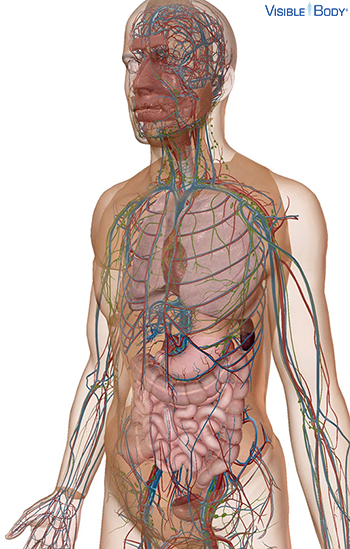
The immune system is the body's defense system against infection and disease. See it in 3D!
System: Lymphatic
Region: All
The innate immune response is a general response involving physical defenses, antimicrobial substances, fever, inflammation, and phagocytes that consume pathogens.
System: Lymphatic
Region: All
The adaptive immune response is a targeted response in which B and T lymphocytes recognize and neutralize invading microbes in the lymphatic system and bloodstream.
System: Lymphatic
Region: All
Function: Activated B cells multiply to produce large numbers of clones, most of which become plasma cells. Plasma cells produce antibodies that recognize antigens on foreign microbes. The antibodies act as tags to identify the invaders. This is called an antibody-mediated response. T cells, activated by antigens presented by phagocytes, multiply then seek out and destroy infected cells.
Lien
The spleen is an organ whose functions mostly contribute to body defenses; it is considered part of the lymphatic system and is the largest lymphoid organ. See it in 3D!
System: Lymphatic
Region: Thorax
Function: The spleen’s varied functions include processing blood to remove dead or defective red blood cells and platelets; recycling iron from red blood cells; producing new red blood cells in the developing fetus; and serving as a site where populations of lymphocytes increase.
Pathologies: Acute lymphocytic leukemia, chronic lymphocytic leukemia, HIV/AIDS, Hodgkin Disease, infectious mononucleosis, lupus, lymphedema, lymphoma, multiple myeloma, myelodysplastic syndromes, Sjogren’s Syndrome
Thymus
The thymus is an organ of the lymphatic system that functions in body defenses.
System: Lymphatic
Region: Thorax
Function: In the thymus, the lymphocytes called T cells—which form in red bone marrow—mature and become specialized. The thymus also produces hormones that are thought to regulate the development of T cells.
Pathologies: Acute lymphocytic leukemia, chronic lymphocytic leukemia, HIV/AIDS, Hodgkin Disease, infectious mononucleosis, lupus, lymphedema, lymphoma, multiple myeloma, myelodysplastic syndromes, Sjogren’s Syndrome
Tonsillae palatinae
Each tonsil consists of lobes of lymphoid tissue aggregates that are covered with stratified squamous epithelium and lined by a continuation of the pharyngeal mucosa.
System: Lymphatic
Region: Head
Function: The palatine tonsils are two of the mucosa-associated lymphoid tissues (MALT), which protect the alimentary canal from pathogens.
Pathologies: Acute lymphocytic leukemia, chronic lymphocytic leukemia, HIV/AIDS, Hodgkin Disease, infectious mononucleosis, lupus, lymphedema, lymphoma, multiple myeloma, myelodysplastic syndromes, Sjogren’s Syndrome
Lymph derives from interstitial fluid that surrounds the cells of body tissues.
System: Lymphatic
Region: All
Function: Lymph is clear and colorless and contains white blood cells. The white blood cells can destroy pathogens and remove some unwanted substances from the interstitial fluid as it flows toward lymphatic tissues and lymph nodes.
Lymph nodes are capsules of tissue that filter lymph and contain lymphocytes that destroy pathogens. See it in 3D!
System: Lymphatic
Region: All
Function: The lymph nodes and lymphatic organs provide the key functional sites of the lymphatic system.
Pathologies: Acute lymphocytic leukemia, chronic lymphocytic leukemia, HIV/AIDS, Hodgkin Disease, infectious mononucleosis, lupus, lymphedema, lymphoma, multiple myeloma, myelodysplastic syndromes, Sjogren’s Syndrome
Lymph circulates throughout the body. It begins as interstitial fluid between cells and filters into lymphatic capillaries, flowing into larger vessels and trunks, and eventually returning to venous blood.
System: Lymphatic
Region: All
Function: Lymphatic vessels and ducts provide the complex transportation network of the lymphatic system.
Pathologies: Acute lymphocytic leukemia, chronic lymphocytic leukemia, HIV/AIDS, Hodgkin Disease, infectious mononucleosis, lupus, lymphedema, lymphoma, multiple myeloma, myelodysplastic syndromes, Sjogren’s Syndrome
Lymph empties into the bloodstream from the thoracic duct and right lymphatic duct, at the junction between the subclavian and internal jugular veins.
System: Lymphatic
Region: Thorax
Function: Lymphatic vessels and ducts provide the complex transportation network of the lymphatic system.
Pathologies: Acute lymphocytic leukemia, chronic lymphocytic leukemia, HIV/AIDS, Hodgkin Disease, infectious mononucleosis, lupus, lymphedema, lymphoma, multiple myeloma, myelodysplastic syndromes, Sjogren’s Syndrome
White blood cells, or leukocytes, are the component of blood that defends the body against disease. See it in 3D!
System: Lymphatic, Circulatory
Region: All
Lymphocytes, the second most common leukocytes, move mostly through lymphatic tissue and briefly through the bloodstream. See it in 3D!
System: Lymphatic
Region: All
B cells develop and mature in red bone marrow before becoming active in the spleen, lymph nodes, and bloodstream.
System: Lymphatic
Region: All
Function: They produce antibodies—substances that recognize the antigens on foreign microbes and act as tags that identify the invaders.
T cells develop in red bone marrow and mature in the thymus before becoming active in the spleen, lymph nodes, and bloodstream.
System: Lymphatic
Region: All
Function: Once activated by antigens—substances on foreign microbes—they seek out and destroy infected cells.
Natural killer cells attack and destroy foreign microbes.
System: Lymphatic
Region: All
Monocytes develop into macrophages and remove debris after an infection.
System: Lymphatic
Region: All
When bacteria or other pathogens are present in the body, certain white blood cells categorized as phagocytes consume the microorganisms to protect the body from infection.
System: Lymphatic
Region: All
Function: The process begins when chemicals from a pathogen, or damaged tissue, attract a phagocyte. The phagocyte binds to the microbe, envelopes it, and then eats it. Enzymes within the phagocyte kill and digest the pathogen. This action is called phagocytosis.
When you select "Subscribe" you will start receiving our email newsletter. Use the links at the bottom of any email to manage the type of emails you receive or to unsubscribe. See our privacy policy for additional details.